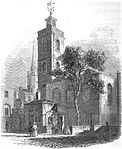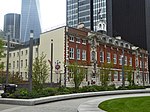Aldgate Pump
Grade II listed buildings in the City of LondonTourist attractions in the City of LondonUse British English from November 2014

Aldgate Pump is a historic water pump in London, located at the junction where Aldgate meets Fenchurch Street and Leadenhall Street. The pump is notable for its long, and sometimes dark history, as well as its cultural significance as a symbolic start point of the East End of London. The term "East of Aldgate Pump" is used as a synonym for the East End or for East London as a whole.
Excerpt from the Wikipedia article Aldgate Pump (License: CC BY-SA 3.0, Authors, Images).Aldgate Pump
Leadenhall Street, City of London
Geographical coordinates (GPS) Address Nearby Places Show on map
Geographical coordinates (GPS)
| Latitude | Longitude |
|---|---|
| N 51.513166666667 ° | E -0.077888888888889 ° |
Address
Tossed
Leadenhall Street 78-79
EC3A 3DH City of London
England, United Kingdom
Open on Google Maps









